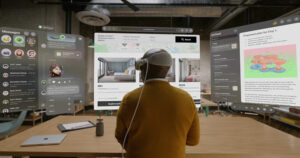
Microsoft on Wednesday announced that it will begin rolling out Windows 8.1 to the general public on Oct. 18.
Win 8.1 will be available as a free update for Windows 8 users through the Windows Store, and it will also be available at retail outlets and on new devices running the Windows OS.
Microsoft appears to be banking heavily on the back-to-school shopping season to push Windows 8.1.
Despite this, Windows 8 supports both consumer and business needs, and “the updates coming in Windows 8.1 will further serve the needs of business customers,” Microsoft told TechNewsWorld in an email from PR rep Diana Cansino.
Microsoft did respond to a lot of customer requests or needs, but “it is not exactly bowing to every wind,” commented Wes Miller, an analyst at Directions on Microsoft. For example, “people would like to have the Start menu back but I see no indication that they’ll fold on this one,” he said.
What Microsoft’s Including in Win 8.1
All first-party apps, including Photos, Music, Video and Internet Explorer, will see improvements, Microsoft said. New first-party apps will also be added.
Bing Search is being updated, and Windows 8.1 will offer easier access to Microsoft’s SkyDrive service and improved syncing between devices.
Multitasking and multimonitor support will be improved.
Windows 8.1 will have more personalization options, with new options for tiles, sizes, backgrounds and color. Settings will roam from device to device.
Microsoft will likely continue tweaking Windows 8.1 but there won’t be any structural or user interface changes, Directions on Microsoft’s Miller told TechNewsWorld. “The kinds of things you can expect between August and October are in the areas of reliability, performance, and any kind of thing that shows up when you localize into other languages.”
Catering to BYOD
There is more appeal to businesses with Windows 8.1, with features such as Work Folders and Workplace Join, than with 8.0, Miller said.
Both of these cater to the Bring Your Own Device trend.
Workplace Join gives IT administrators fine-grained control over corporate resources. For example, they can grant some access to BYOD devices while enforcing some governance parameters on them.
Work Folders lets users sync data from their user folders in the corporate data center to their devices and vice versa. This syncing does not require domain joining or domain credentials, and can be performed with third-party folder replication apps. IT can enforce Dynamic Access Control policies on the Work Folder Sync Share.
Windows 8.1 also offers mobile device management, and supports wireless and NFC printing from devices.
Enhanced Security
Windows 8.1 will let corporations mark enterprise content as corporate, encrypt it, and wipe it when their relationship with a user ends.
It will include biometric capabilities that will let users authenticate their identity anywhere in Windows. It will also be optimized for fingerprint-based biometrics.
Device encryption will be enabled out of the box, and consumer devices are automatically encrypted and protected when using a Microsoft account.
Windows Defender and Internet Explorer 11 have been enhanced for security, and all versions of Windows 8.1 will include Assigned Access, which lets users create restricted access to Windows Store apps.
The Windows Store is enabled by default.
What Win 8.1 Improvements Might Mean
“Those enterprises that are embracing touch on PCs or want a tablet that is manageable like a PC will find Windows 8.1 a no-brainer upgrade from 8,” Al Hilwa, a program director at IDC, told TechNewsWorld.
“However, very few enterprises have deployed Windows 8 widely, so it’s less of a migration issue and more of a new adoption situation,” Hilwa continued.
Whether Windows 8.1 will see a rapid pickup is in doubt, because “Microsoft is forcing people to dabble with the modern UI by making the Start menu a modern screen,” Hilwa suggested. “To users and OEMs, it is a head-scratcher as to why Microsoft would take a successful desktop user interface and remove a crucial element of familiarity and comfort like the original Start menu.”






















































Dead
Man
Walking.
No one wants Win8, and much more importantly, no one CARES.
Windows 8 and 8.1 are primed to follow the Kin and the Surface tablets down the toilet of technology history, likely dragging XBox and Ballmer down behind them. Good comments in the article; it’s as if MS is actively TRYING to force customers away.
Unfortunately it doesn’t seem to be pushing that many new ones towards Linux, just towards Android and Apple and even "Chrome".
Actually just like Vista its a boon to us small shop owners as we can get paid quite well to make Metro go away, in fact this is one advantage Win 8.x has over Vista in that I can make Win 8 into Win 7 with an hour or two with the right tweaks (no it takes more than just replacing the shell with Classic Shell, you have to do some registry editing and driver hacking to keep the charms and junk from popping up) so they don’t have to go out and buy a new OS.
But as someone who has been building, servicing, and selling PCs since the days of The Shat selling VIC 20s with his TJ Hooker hair I can say I have NEVER seen an OS that is a big of a mess as Win 8.x, never. I learned Android in less than 30 minutes, about the same for OSX, I have even mastered some of the funkier Linux DEs and know my way around a CLI but Win 8 is the ONLY OS that has ever made me so mad I actually flipped off the laptop in frustration.
The problem is its obviously a TOUCH ONLY OS and since most laptops are NOT TOUCH and touch laptops just aren’t selling MSFT has tried to make the touchpad into a touch UI and it just doesn’t work. A touchscreen tells the OS EXACTLY where you are and what you are doing whereas a touchpad like a mouse is all relative movement and it doesn’t take too many charms bar pop up and swipe gestures when they are trying to just scroll a web page for people to start cursing in frustration.
So while its great for us small shop guys I’d say if MSFT doesn’t change course when Win 7 goes EOL so too will that be the EOL of the Windows desktop as folks HATE the Metro UI and its NEVER gonna replace an actual OS built for a laptop/desktop.
Something must be AM iss because I’m agreeing with you. 😉
Only notes I would add are:
a. That is hardly "hair".
b. If it takes 2 hours to fully banish Metro then perhaps the customer might as well have paid for a Win7 retail pack instead. (Also still pretty funny to me that Win8 cost 40 bucks when released but Win7 still costs… holy crap, $200 at NewEgg for Home Premium retail?)
c. Yes I realize you’re probably doing some other value-add things like antimalware and decrapification.
Oh, also, their new idea is to push the hardware makers to go exclusively touchscreen laptops to make Win8 bearable… but soon they will have so little sway it will hardly matter. I wonder if everyone will be running Chrome on their laptops in a few years, though that’s hardly a real OS (Linux running the Chrome browser).